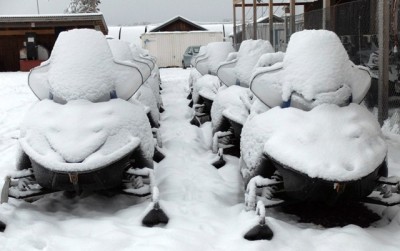You know you live somewhere a bit different when a political party throws a party to thank local voters for not electing it. Or perhaps, just when a political party throws a party. It’s Kiruna, and a ‘kalas’ is nothing special.
‘Kalas’ translates roughly as ‘party’, only you have to let go of any adult associations you have with the word. This isn’t something you need a cocktail dress for, and you won’t find a finger buffet and a glass of chilled white wine here.
A ‘kalas’ has more of the feeling of a bean feast, a good old-fashioned having-a-bit-of-fun sort of party. A ‘kalas’ is what children like to go to, and in Kiruna adults like to go to one too. Dress code is come as you are (ski pants), and the main attraction is cake. Ideally cream cake, but there will be other varieties. And coffee (everything in Sweden comes with coffee – even coffee comes with coffee).
This Saturday there will be a ‘Tårtkalas’ in Folkets Hus, the community centre in town. That roughly translates as a ‘cream cake party’. The host of the party is Kiruna’s ‘centre party’, who increased their percentage of votes in a recent election but failed to gain the majority. As it’s a party thrown by a political party you’d be forgiven for thinking Boston Tea Party here, likely to involve some kind of political protest, possibly involving throwing cream cakes at the political winners. But no. This will be a most civilised affair, where all sorts of people (regardless of who they voted for) will indulge in free coffee and cake while chatting to friends and neighbours.
It’s not uncommon. In fact, we went to one last week. That one was thrown by the local water/energy/rubbish company, Tekniska Verket. There was a good turn out – Folkets Hus cafe was full, and there were at least three different kinds of cake. And the reason for the party? It was the first of advent, people were out in town anyway, so Tekniska Verket saw an opportunity to make themselves loved. Good on them. They were loved, and disgruntlement about rubbish collection (why are their systems so inflexible they refuse to collect our bins when they’re turned the wrong way), energy (we can’t afford to pay to be connected to the communal system), and roads (why have they removed the hump to slow down traffic at the bottom of our road) is forgotten, at least for a day.
The public ‘kalas’ is part of Kiruna culture. It’s a free-for-all, a welcome all-comers event that I think reflects the best of society here. In general I experience Kiruna as a more equal kind of society than most. No community ever has total equality, of course, but there are degrees of equality, and here I must say I feel I’m as equal as I’ve ever been.
Kiruna was established as a mining town at the turn of the last century, and the owners of the mine and the workers did not live in an equal society. But compared with other industrial societies in Sweden, or elsewhere in the world at the time, Kiruna was in many ways a more equal society. Being so far away from other towns, and in the beginning extremely isolated (no roads, no railway), the town was designed to attract workers and keep them. It was a ‘model’ town, built to face the sun, with facilities for workers and their families unheard of elsewhere. The town even had a tram to take workers straight to the mine, and had electricity as early as 1907.
The first director of the mining company (LKAB, the same company here today) was Hjalmar Lundbohm, and he is still regarded as a sort of father of the town. He took an interest in the lives of the his workers, and provided education, sports facilities, and more importantly, a decent wage.
Elsewhere in Sweden, industrial towns were built on a plan where top management lived in big houses on one side of town, and the workers in small flats on the other. You don’t see this pattern in Kiruna. Large and small houses are mixed together. Houses for workers were specially designed to have the same feel around them as the ‘grand’ houses. Lundbohm himself refused to move into a grand house, and the relatively modest house he lived in is still in the same place, and possible to visit. All the old part of Kiruna, where the mining company provided housing, is soon to be emptied, because of the need to move the town.
But we were talking ‘kalas’ and free-for-all. Lundbohm was partial to a good ‘kalas’, although I have to admit that they weren’t always free-for-all. Sometimes they were just for the royals and the great and the good from Stockholm, because he was very good at PR for the company and knew how to get them on his side. Sometimes they were for artists, because he liked art and didn’t think that just because Kiruna was so far north it meant it shouldn’t be the subject of paintings, or a place where art flourished.
But alongside these other parties, Lundbohm also liked to throw a ‘kalas’ for locals. His most famous ‘kalas’ were at Christmas, for the children of the mine workers. For many years Lundbohm liked to begin his ‘kalas’ with a reindeer ride and the sled that was used to bring the children to the ‘kalas’ still lies outside his house. Then there were games, and a Christmas tree, and more kinds of cake than you could eat. There are still people living in Kiruna who went to these parties as children.
Last week the mining company, LKAB, didn’t throw a ‘kalas’, but it did invite us all to a ‘glöggmingel’ in town. Ah yes, a ‘mingel’…. well it’s a social event where you, er, mingle. And now you know what a ‘tårtkalas’ is, you can work out that a ‘glöggmingel’ is an occasion where you socialise and drink mulled wine (‘glögg’).
So we went. Only when we got there there was no ‘glögg’, just some cold bottled fizzy drink. And no cake. So we went upstairs to Tekniska Verken’s ‘kalas’ instead. LKAB seem to have lost their knack with ‘kalas’.












